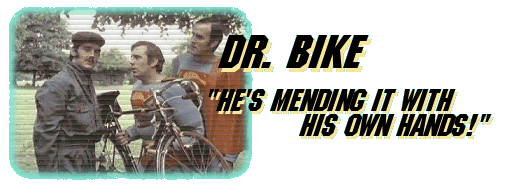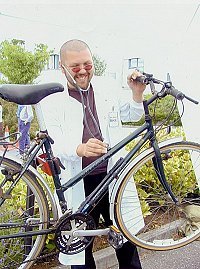

 |
||
 |
||
|
|

The History of Dr. BikeDr. Bike started off back in the mists of time, probably in one of the big American cities with a strong bike culture, when bike shop mechanics realised that Critical Mass riders were in many cases riding utter sheds, often skip-salvaged and dangerous. These mechanics would take along a toolkit and offer to check over the bikes which were present, to make sure that they were safe. The meme took root, and now Dr. Bike can be seen at large green events or mass bike rides.That's probably the history. The good Doctor's true origins are shrouded in mystery. I first saw Dr. Bike at Critical Mass in Bristol. He was doing moderately violent things to some crusty Massers' bikes, and it was immediately obvious to me that this was a Good Thing. Most commonly, Dr. Bike is a mechanic from a local bike shop; the free advertising is a bonus and when you have a really bad one, you can refer them to your workshop and that brings in trade. Sometimes the Doctor is a 'civilian' enthusiast instead. Anyone with the knowledge and a decent toolkit can be Dr. Bike. Why do I do Dr. Bike? Bikes are great: they are cheap non-polluting transport for the masses ("When I see an adult on a bicycle, I do not despair for the future of the human race." - H.G. Wells). Bikes involve their rider in the environment and community on many levels, where cars separate drivers from their world behind glass and air-conditioning ("The bicycle, the bicycle surely, should always be the vehicle of novelists and poets." - Christopher Morley) and they're just plain fun. Mostly, I do Dr. Bike because I like tinkering. I enjoy a challenge.
Bikes are great: they are cheap non-polluting transport for the masses ("When I see an adult on a bicycle, I do not despair for the future of the human race." - H.G. Wells). Bikes involve their rider in the environment and community on many levels, where cars separate drivers from their world behind glass and air-conditioning ("The bicycle, the bicycle surely, should always be the vehicle of novelists and poets." - Christopher Morley) and they're just plain fun. Mostly, I do Dr. Bike because I like tinkering. I enjoy a challenge.I love seeing people with ill-fitting bikes go away on smooth machines. I like that marginal bikes return to being viable transport. I think it's good that free services are offered, as sometimes you get to see the unwaged or strapped, who would otherwise not give their bikes the love they deserve. I like showing people how to adjust their bikes. Dr. Bike is a small force for social good. Where does Dr. Bike turn up? Clearly, the good Doctor spends much of their time in some secret underground workshop, but can commonly be seen around the start of large Critical Mass rides, at other big bike events, on Bike Week or Car Free Day, at schools, and at corporate cycling promotions. I cut my teeth in the role at the Environment Agency's Green Fair. How can you do Dr. Bike?How do you don the white coat of cosmic goodness, then? You'll need some tools and ideally a workstand and a bit of shelter from the elements. I take along a stack of checklists (download a PDF version here), one for each bike. The white coat is optional.How much work you do on each bike depends on how many bikes you're expecting to see: at a big urban Critical Mass you might give each bike a ten-minute once-over, at a green event you could perhaps afford up to half an hour. Don't do big repairs: recommend a couple of good local bike shops and give the patient a copy of your checklist if there's big work to be done. This is triage, not surgery. One day, I'll get a M*A*S*H tent. That's about the right vibe. Get the word out well in advance of your session to be sure of customers, or you'll get loads of people on the day turning up and saying, "Oh, If I'd known you were here I would have brought my bike." I hate hearing that. Make sure your Doctoring is well-publicised! Common ProblemsPatients come in three flavours: the good, the bad and the ugly.Good bikes are strange. They're usually high-value bits of decent kit, and often well-maintained. People who check a good bike in with the Doctor either have a weird little niggling problem, or are showing off their lovely machine. Which is cool, 'cos we wouldn't be doing this if we didn't love bikes. I've found that with good bikes, you can go over the checklist incredibly quickly, and if you find a problem at all, it is often a to-the-bike-shop job. Bad bikes are cheap and they've usually been in the shed for a couple of years. The tyres are half flat, the chains are dry, and they need love. Give them love, it's what you're here for. Ugly bikes, now there's a whole other fishkettle. Ugly bikes were usually cheap when bought and have been outdoors for a lot of their lives. Children have probably trashed them a bit, and there's corrosion and spider-eggs everywhere. And then you try to fix them and realise that the mechs are seized and the cables corroded and the brakes are death-traps. Cut your losses with ugly bikes. Assess them, and come back to them if it is quiet. Do not expect to resurrect every ugly bike - though it's a hell of a boost when you do! The most common problems I've encountered are:
Kit ListHere's what I take to a Dr. Bike session. If you're clever with the packing, this will all fit nicely into a bike trailer with room for a flask of coffee.
Musings on the DoctorIt struck me, while post-morteming the Bike Week 2003 Dr. Bike session at the Environment Agency, that Dr. Bike is almost a small god. Invoke the Doctor? There's a role (fixing any bike for free), a set of attributes (all comers welcome, greasy hands, mug of tea, resurrection) and a costume (workstand, toolkit, white coat)... get the workstand out and the spirit of the good Doctor descends like some Loa only without the shaking or the funky drums. Give me sixteen bikes today and I'd whimper and fold; the Doctor eats them up and asks for another fiddly one. Perhaps he belongs in among the other Forge and Smith Gods, only round the back, in the bike shed.And Finally...I really hope that this has inspired you to pack your tools up and do a Dr. Bike session of your own. Have a word with your employer or local school and see if they're interested. It's a fun way to spend a day, and you'll feel ever so chuffed whenever you see your patients riding around instead of festering in sheds. Give it a try. Let me know how it goes, and if you've any questions, don't hesitate to drop me a line.
|
||||||||||
  
|